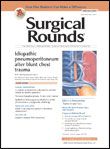Publication
Article
How to Best Handle Cases of Bad Aorta
Author(s):
Although patients who would have been considered high risk 10 years ago can now successfully undergo percutaneous cardiac intervention, those with severe sclerotic lesions in the ascending aorta still present a challenge to surgeons.

Although patients who would have been considered high risk 10 years ago can now successfully undergo percutaneous cardiac intervention, those with severe sclerotic lesions in the ascending aorta still present a challenge to surgeons.
In an article published in the May 2014 issue of General Thoracic and Cardiovascular Surgery, Kazuyoshi Tajima, MD, reviewed strategies to handle such cases of bad aorta and outlined the approach utilized by the Nagoya Daini Red Cross Hospital in Japan.
According to Tajima, sclerotic lesions between the ascending aorta and the aortic arch elevate risk for cerebral and visceral vessel embolization, with operative mortality and cerebrovascular accident rates hovering around 10%. Depending on whether the patient presents with severe aortic wall calcification, liquid-rich atheroma in the aorta, or both, surgeons may refer to bad aorta by another name, such as shaggy aorta, porcelain aorta, or eggshell aorta.
These aortic diseases create fragile situations for surgeons. While preoperative unenhanced computed tomography (CT) scanning is often used to assess the ascending aorta and identify calcification, this visualization misses atheroma. However, enhanced dual-helical CT with thin sections can increase atheroma detection, and transesophageal echocardiography (TEE) and magnetic resonance imaging (MRI) can also be utilized.
Since the goal of imaging studies is to detect the degree of disease prior to surgery, the Nagoya Daini Red Cross Hospital uses high-quality intraoperative epiaortic ultrasound via a handheld probe to increase its surgeons’ awareness of aortic problems with little burden to patients.
While reviewing several operative procedures that address special circumstances, Tajima noted the selection of an appropriate technique depends on the cannulation site for a cardiopulmonary bypass, whether it is possible to clamp the ascending aorta safely, and whether incision and suture of the ascending aorta are possible. Tajima felt optimistic that cardiac surgery outcomes in bad aorta cases will continue to improve as techniques are refined and surgeons become more skilled at selecting the best procedures.






